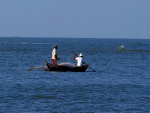
How India evacuated nearly 2,300 citizens during Israel-Lebanon war 2006!
PTI, Jun 16, 2019, 1:53 PM IST

New Delhi: India had carried out one of its best evacuation operations from a war-like zone in 2006, when it brought back home around 2,300 people, including some from Sri Lanka and Nepal, who were caught in the Israel-Lebanon conflict, says a new book.
In Challenges of Governance: An Insider’s View, former Cabinet Secretary B K Chaturvedi recalls his experiences as a top bureaucrat on issues of governance, coalition politics and handling emergencies, like the evacuation of Indian citizens from the simmering war zone 13 years ago.
It was a rescue operation designed to provide support to those persons, mostly Indian citizens, who were caught in the war-like zone of Lebanon-Israel, he says, noting that 12,000 Indians were living in Lebanon at the time.
Chaturvedi, who was overseeing the developments from New Delhi, recalls that tension was escalating in the region and travelling by road was becoming increasingly dangerous so the government opted for sea route to bring them to a port in Cyprus from where Air India planes would fly them to Delhi.
The Israelis started bombarding Lebanese positions, and there was a naval blockade of the Lebanese coast. With escalating tensions, the Indian embassy in Lebanon evacuated families of its staffers, as it was becoming a dangerous conflict zone and lives were in danger.
This evacuation was done via neighbouring Syria. The families travelled by road to Syria and then from its capital, Damascus, undertook an onward journey to India. But this was worrisome, for there were about 12,000 Indians living in Lebanon then, and many were scared for their lives. There were also a large number of residents from other South Asian countries, the US and Europe who wanted to be evacuated, he says.
On July 18, 2006, while discussing the situation with the foreign secretary and the chief of naval staff he said they were informed that several Indian ships were in the Mediterranean Sea region for naval exercises, and that they were returning and could be used for the Lebanon evacuation.
There were, however, several risks, for which we had to be adequately prepared. The decision had to be taken immediately, as our ships would be entering the Suez Canal any time, and once they did, their return would be time-consuming. Traffic was only one-way and the movement was strictly controlled by Egyptian port authorities. The width of the canal was small and did not permit any U-turns.
“Our ships were going to be involved in a humanitarian exercise and we were worried they might get caught in the crossfire between Israel and Lebanon, Chaturvedi adds.
Indian ships heard a lot of messages and communication chatter which made it clear that Israel was going to put a blockade on the Lebanese port, while several people who were to be evacuated lost their papers in disturbed conditions and had to be given temporary documents, he recalls.
Coordination was required with Cyprus authorities. Our High Commissioner in Cyprus and ambassador for Lebanon needed to be in close touch with the local authorities and the government of Israel. We needed an understanding so that the exchange of fire between Hezbollah and Israel could be temporarily stopped when the evacuation process was going on, Chaturvedi says in the book, brought out by Rupa Publications.
We worked out a plan so that those wishing to be evacuated could be helped by the Indian embassy and moved to Beirut. Ships of the Indian Navy were then to be used to evacuate them to Larnaca, the neighbouring port of Cyprus. Air India was then expected to bring them back to Delhi, he says, adding the prime minister was also briefed.
Further the Indian authorities needed to negotiate several issues despite previous formal communications to ensure the transit was smooth and seamless.
… This required constant liaison with the local authorities. This was important, as many of the people being evacuated from Lebanon did not have complete travel documents.
Immigration and security issues had to be sorted out. The problem was compounded as coordination with the Lebanese port authority was required and getting to them was a problem. Considering that more than 2,000 people were coming to board the ships, extensive arrangements were required for the journey, he says.
Chaturvedi recalls Air India did not operate from Cyprus then and special permission was sought for allotting parking bays to the a number of flights of the national career, while the Indian Ambassador to Cyprus Neelam Sabharwal was in touch with local authorities to enable a quick issue of visas to the Air India crew.
Also, since getting visas for so many people travelling via Cyprus was not acceptable to their government under the European Union (EU) system, a novel system of transit slips was evolved. This would enable a transfer of passengers straight from the naval ships to the Air India aircraft.
Our preparations paid off and the evacuation process went smoothly, and was well appreciated by both the NRIs and neighbouring Sri Lanka and Nepal, whose citizens were also brought home by the Air India flights. Nearly 2,300 individuals were evacuated. It indicated the effectiveness of our system in emergencies, he says.
Sabharwal, later recalled to me, India’s evacuation operation via Cyprus was considered as best coordinated and most efficient by the government of Cyprus, foreign correspondents, diplomats and international organizations. In fact, it was described a role model for the EU and other nations to emulate’, he writes.
Udayavani is now on Telegram. Click here to join our channel and stay updated with the latest news.
Top News
Related Articles More

Congress to discuss candidates for Amethi, Raebareli seats on Saturday

Cache of arms including foreign-made revolvers seized by CBI in Sandeshkhali raids

24 Indian Fishermen Released from Sri Lankan Detention, Repatriated to India

SC verdict on EVM tight slap to Congress-led opposition: PM Modi in Bihar rallies

Board exams twice a year from 2025: MoE asks CBSE to work out logistics, no plan for semesters
MUST WATCH
Latest Additions

Patanjali Foods to evaluate proposal to buy Patanjali Ayurved’s non-food business

Congress to discuss candidates for Amethi, Raebareli seats on Saturday

BJP’s CT Ravi Booked for Promoting Hatred and Enmity Through Social Media Post

Elections held in 14 LS segments in Karnataka, voter turnout nearly 64 per cent till 5 pm

‘PM is scared, may even shed tears on stage’: Rahul Gandhi’s fresh salvo at Modi
























